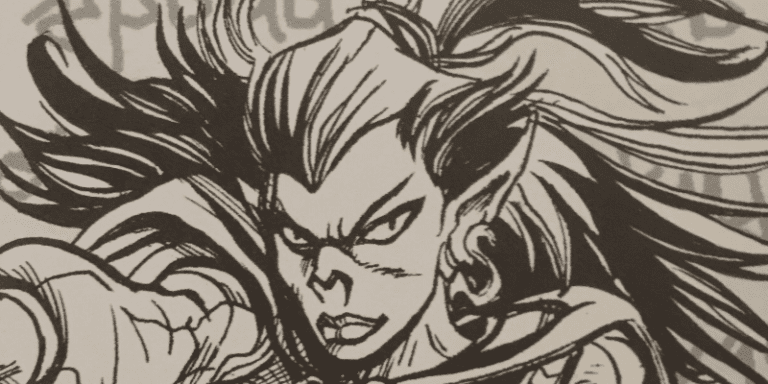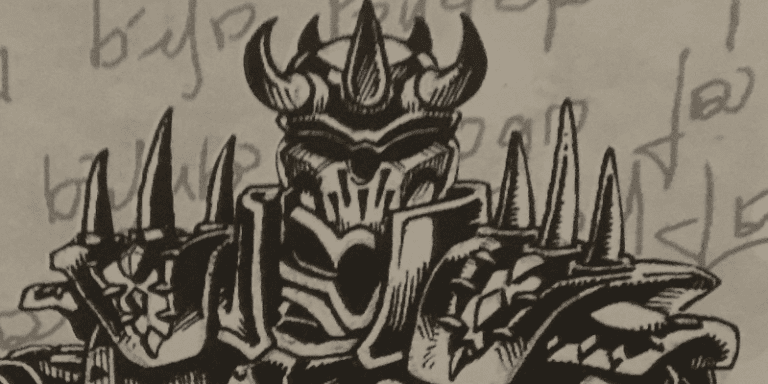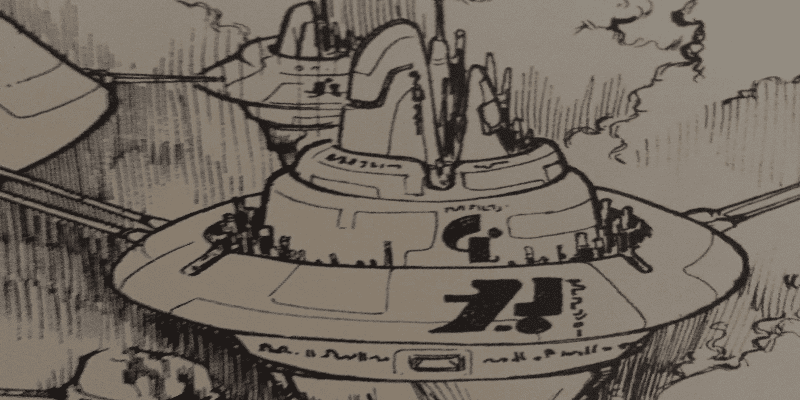The Secret of Zir’an, Part 3

I am returning to The Secret of Zir’an this week with one of my favorite parts of the book: character creation. While every game system has their own version of creating a character, this game does so in a way I would love to see adopted to other systems. In fact, the early playtest versions of D&D 5e came very close to this. You might not remember, but there was a time in the playtest where you chose a specialty that went along with your background and your class, and some of the current background and class features were found in this specialty selection instead. This created a very modular character creation design, and allowed for the emergence of some really cool fantasy archetypes you typically have to work really hard to portray in the more stringent confines of D&D. The Secret of Zir’an takes this idea to the extreme. Instead of selecting classes, backgrounds, and even specialities, the game says, “build the life of your character.”
Part One | Part Two | Part Three
It’s a shame this book is so illegible, because this section’s layout is impeccable. It starts off detailing character creation for different campaign power levels. Other games tend to band play by levels, and I know Pathfinder does something similar in the initial stat distribution, but these are linked systems, so it’s a more complete view of the system by its very nature. The three tiers in order of power scale are tyroic (a word they made up), heroic, and legendary. Importantly, the book provides guidance on the upper limits of advancement. Remember how there were four ranks of Finesse Level? In a tyroic campaign, you cannot have a skill higher than Advanced. That’s a huge power shift, and easy to recognize thanks to the ranks of the system.
Power. My people are addicted to it.
The tyroic power level package grants 10 points to distribute to primary stats, 2 points for derived stats, and 50 character creation points to spend on building the life of your character. The heroic power level package grants 12 points to distribute to primary stats, 4 points for derived stats, and 75 character creations points. The legendary power level grants 15 points to distribute to primary stats, 6 points for derived stats, and a whopping 100 character creation points.
What’s really neat is you can tell just by the character creation point totals what the power levels represent, as you spend the character creation points building the character’s life. With 50 points, tyroic characters are average people or are just above average, about to embark on their journeys. They are green recruits, novice scholars, or newly trained magic-users. Heroic characters are professionals in their field, ready to find their first big adventure. Heroic characters can’t have any skill higher than Expert. They work as officers, seasoned explorers, journeyman drivers, and so on. Legendary characters are your major political players, movers and shakers, and the people who shape the Fate of the world. Legendary characters can have skills all the way up to Elite.
When creating a character, you choose a race, an Origin, distribute stat points, and then purchase skill packages, battle arts, martial arts, and Valdreyr. This section doesn’t delve into the specifics of these areas, but keeps everything at a high level. If you are familiar with White Wolf systems at all, then you’ll not be surprised to find Valdreyr is just a fancy word for both Advantages and Disadvantages you can purchase only at character creation. You spend character points on positive Valdreyr, and gain character points for negative Valdreyr. The twist is you can’t have an absolute value of positive and negative Valdreyr that exceeds your character’s age. This is really important, because your skill packages and Origin governs your character’s age.
And the race is on!
There are five playable races in Zir’an, and a whopping twenty Origins. Origins are simply the different nations and territories the characters can be from. Depending on the race, certain Origins might not be available to you. Origins, in turn, determine what skill packages are available to you at character creation. Most of the skill packages are generic, but there are usually a few that are specific to that area, or a small subset of areas.
The playable races are the Ianer, Dolonorri, Gogach, Neolli, and the Zhalanti. These are mostly fancy words for the races you know and love, though with some pretty decent changes you don’t see often. Ianer are humans, Dolonorri are dwarves, Gogach are giants, Neolli are a variety of savage beast people, and the Zhalanti are elves. This isn’t anything too unusual, and many of the expected tropes are present. However, the book does depart in several ways, all interesting enough to warrant a little discussion.
The Ianer have the most options of the races and possess the adaptability so often spoken of in other systems. That is expressed here as a free 4-point Valdreyr signifying their unique natures. They see themselves as the inheritors of the modern world. Specifically, the Ianer adhere to the idea of Manifest Destiny. You often see imperialism expressed in many fantasy and sci-fi settings, but it’s colonization of the New World imperialism rather than 19th century imperialism. The Ianer claim the divine right of the Seven Gods, and each seek to be the chosen nation. However, they are trying to do so to better the world, rather than out of simple material gain. While those are still driving goals, they look to the lessons of the past to avoid the greed and decadence of the previous empires. You could easily imagine these Ianer saying they are born of “a sense of mission to redeem the Old World by high example.” This really helps hammer home the time period the setting is trying to capture.
Dolonorri are typical Tolkien dwarves (As an aside, why do people give Aulë a pass but hate on my boy Fëanor? Ridiculous) mashed with tinker gnomes. They are people of the earth, created by the gods to run the machines and craft things of beauty and purpose. They were an insular people that stayed inside the world. Until they didn’t. They decided to become involved in the world above, and that caused them to be swept up in the Fate that binds all of Zir’an, subjecting them to the cycles of the world. Purity of blood has become a huge deal, as Ianer intermarried and bred with the Dolonorri. You know the weird caste dwarves of Dragon Age? Yeah, that’s actually what the Dolonorri now resemble. This book came out many years earlier, of course. Their society has developed into rigid castes. The Dolonorri receive a mass bonus, an acuity penalty, if you are from the dwarven homeland as your Origin, you get the Mechanical Affinity Valdreyr, but all Dolonorri get a flat +2 bonus to the mechanics skill. Importantly, all Dolonorri add 10 to their starting Origin age.
In a bold move, Zhalanti are pretty much straight up Silmarillion elves. They are amortal beings, unable to die to disease or old age, though still able to die if you murder them or whatever. They were with the Seven Gods in their first creation, who may or may not be Valinor, and they came with the Seven Gods to the new creation where the setting exists. For them the gods created Ylar, the wellspring of magic, which may or may not be a tree of light. The Zhalanti divided themselves into two groups as the world expanded, and new races began to rise: those who would shelter themselves, and those who would see to the world. Look, they are Eldar and Avari, ok? If you prefer, you could perhaps divide them as Calaquendi and Moriquendi. Anyway. They have a bonus to all Knowledge tests while not stressed, they are immune to disease, perceive as clearly in starlight or faint light as in daylight, and cannot die from old age. While cool, this is actually sort of a negative in the Zir’an system, as age affects your aptitude, something not variable for the Zhalanti. Rather than the long life, long learning cycle other games might present, these are elves that double down on the concept of being embodiments of the expression of ideals. They aren’t likely to change their basic natures.

On the other end of the scales, you have the Neolli. Neolli are magical mutants created by the evil shadekin. They are misshapen beast people that have softened over the generations, but are still obviously savage beast people. In fact, they are vampire bat predator people without the wings. They have the most changes to them, too. They get a bonus to acuity and physique, a penalty to intelligence, a bonus to hand-to-hand combat, their claws have a higher armor piercing rating, they have stackable bonuses to athletics and climbing, they have crazy good vision, and a bonus to perception in the wild, which converts to a penalty in urban environments. They also have a base age of 8, regardless of any other Origin modifications.
Finally, you have the gogachi. The gogachi are fire giant children of Hephaestus, basically. They have a hard time communicating, so everyone assumes they are dumb, but really they are just experts of non-linear thought and spatial relations. They get a massive +5 bonus to any spatial reasoning roll, which includes mathematics, guns, visual puzzles, and runemagic. All they have to do is spend ten minutes playing the elaborate game they invented to help them with their reasoning first. They basically play computer games to help their hand-eye coordination. For real.
There are a ton of Origins. So many, in fact, they deserve their own separate article, as it’s a big insight into the setting and world-building. What I’ll quickly address here is what the Origin stats look like. You have the languages associated with it, base stats, max stats, what Origin Valdreyr is open to you, base aptitude, skills in which you can assign your Origin bonus, and your beginning age. As a fast example, if you select the Arivonnean Origina, you know the Erimani language, you have a 4 (12) in Physique, 3 (10) in Mass, 4 (12) in Intelligence, and 5 (14) in Acuity, where the first number is the base and the number in parentheses is the max. You begin with a 1 in all aptitudes, and can assign one more point to either personal or social. Your Origin Valdreyr is Weather Sense, which helps with piloting. Arivonneans begin at an age of 16, and can assign two points of practice to a variety of skill, such as Knowledge (mechanics) or Personal (awareness).
The age is the important thing here. I know I keep harping on it. Here’s why.

To pay the bills
Skill packages. Skill packages cost character points, and do a number of things. First, they cost a fairly high number of points. Out of your starting 50, if you are tyroic, something like Arivonnean Pilot costs you 13 points. When you purchase this skill, this package increases your age by two years, as that is how long it took you to master this package. It increases your aptitude by one. Remember, as your age increases, your aptitude increases, but your stats decrease. It also grants one language, though only a common language (there are lists of common, uncommon, and rare languages provided). Finally, it gives you 7 skill points you can assign to a number of skills it provides.
The cool thing here is you can decide to take the same package multiple times. If you really want to be a badass pilot, you spend another 13 character points, your age increases by another two years, and so on and so forth. I can’t stress enough how much I love this. Let’s take the tyroic example from before. You have 50 character points to start off. You’ll want to spend some of those on Valdreyr, and probably a bit on a battle art or martial arts. Just to be safe, let’s spend no more than 40 points of that total. If you stuck with the pilot, you could do it a third time, and you’d end up at age 22, if you were Arivonnean, starting at age 16 and spending six years in service as an Arivonnean pilot. However, maybe you don’t want to do that. Maybe you want to be a mountain trooper. You spend 20 character points twice over, and you tack on 8 years to your character instead. Now you are 24 rather than 22, and you have more skills in a smaller set to show for it. You could also mix and match, spending 16 character points to be an engineer, and 24 points to be a member of the underground. You’d be 22 again, but your skills would be much more diverse. In any case, you are just over the cusp to adulthood and have no penalty or bonus to your stats. However, you could certainly have spent a little bit less in these skill packages, and end up at only 20, still a Youth. As a Youth, you’d get a bonus to your Physique, but a penalty to your Acuity. It gets more interesting the more character points you start with, as characters can easily get into their mature age brackets, altering stats even further.
You are building out the life of your character when you select your skills. This is so much more evocative, to me, than something like class and background. Sure, you might be a fighter with the Soldier background, but here you’d be someone martially trained who spend a few years as a mountain guardsmen, and then joined the underground as soon as she had the opportunity. That sort of evocative narrative, based solely on your creation choices, can certainly exist in a system like 5e, but it’s a much less common thing. I also love it because it’s selling you the concept along with the skills. You get tie-ins to the same sort of community and training. You have a world awareness that goes along with it solely by the virtue of knowing how this interacts and exists with the world.
Everybody’s a hustler at heart
Character advancement is a little more freeform, but it is still intrinsically tied to this skill package system. Experience rewards are meant to be pretty low. The system stresses good roleplaying and builds it into the reward system for experience. The Hand of Fate (GM) awards a bonus based on true-to-character roleplaying that is good for the whole party. If heroic efforts or sacrifices occur, you are encouraged to hand out a bonus for that, as well. Similarly, clever strategies, quick thinking, and the danger level the players risked all provide experience bonuses. In a way, this is experience as governed by the players, but it entirely hinges on their willingness to tempt Fate. It’s a cool tie-in to the core mechanics of the game, and is doing some pretty indie things long before indie games were doing them. Remember, this was meant to be a major product. Finally, the GM as the Hand of Fate can award them experience based on any goal completions, scaling with how major of a goal was completed.
You raise a skill’s practice by spending experience equal to the level the skill is becoming, so spend two points to raise a practice from 1 to 2. You can improve your stats by declaring you are focusing on that during your adventures, and it generally takes several months of focusing on that stat to earn the right to purchase it. It costs the same as raising a skill’s practice, though it costs much more time. Again, we see the toll of time playing a huge role in the game. Aptitude increases are only awarded by the Hand of Fate, at the end of major goals. Once a major goal has been completed, you may spend twice as much experience as increasing a skill’s practice to raise the Aptitude. Once you have “unlocked” the increase, you can spend the points at your leisure. You don’t need to hoard them and then spend them immediately when the goal is completed, or anything. Finally, to increase a skill’s finesse, you have to spend time. Lots of time. In fact, it’s like you are selecting a new skill package. You train under a teacher or organization, and then you can spend the points accordingly, as well as increasing your age!
I better wrap this gavel up, B
I really can’t say enough good things about this system. I think this sort of character creation and advancement is so good for both the GM and the players. It’s a system of mutually reinforcing story mechanics. The more the players interact with the world, the more of the world that responds to them in kind. It also stresses that the adventures are episodic events, rather than a world constant. The players go off, complete their adventures, and then train and prepare for the next adventure they are going to undertake. It’s a cinematic approach to gameplay that is lost in the more episodic adventures that are currently common. There’s nothing wrong with an ongoing weekly session, I run one myself, but I love this approach so very much. It’s sweeping, it’s in-depth, and it provides content while also improving characters. Rather than just getting better at Riding, the character is really going to care about the Ballinorian horsemen they trained with. They learned Riding from those guys! How dare someone come after them! At least, that’s the theory.
This is already really long, so I’ll end here for now. Next time around, I will dig into the setting material of the Origins, which tells us a lot about how zany the game really is.




